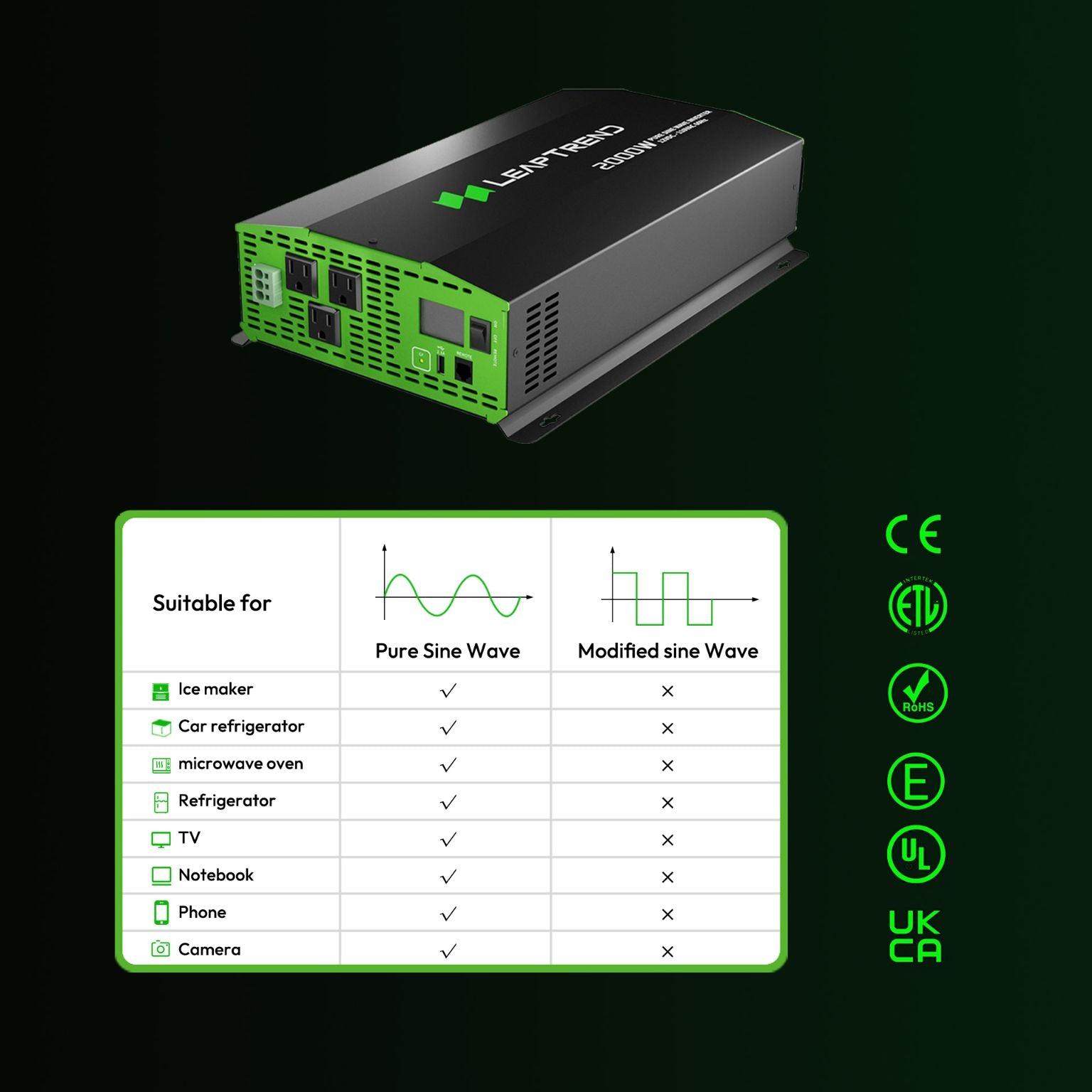Welche Kabelgröße für einen 2000-Watt-Wechselrichter?
Die Wahl des richtigen Kabelquerschnitts für Ihren 2000-Watt-Wechselrichter ist entscheidend für Sicherheit, Effizienz und die Vermeidung kostspieliger Schäden. Zu dünnes Kabel führt zu Überhitzungs- oder Brandgefahr; zu dickes Kabel verschwendet unnötiges Geld. In diesem Leitfaden vereinfachen wir die Auswahl des richtigen Kabelquerschnitts und erklären, warum die vorgefertigten Kabelsätze von Leaptrend die erste Wahl für eine problemlose und zuverlässige Installation sind.
Warum die Kabelgröße bei einem 2000-Watt-Wechselrichter wichtig ist
Ein 2000-Watt-Wechselrichter kann, insbesondere in Niederspannungssystemen, erheblichen Strom ziehen. Die Verwendung von unterdimensionierten Kabeln kann:
- Überhitzen Sie die Kabel, schmelzen Sie die Isolierung oder verursachen Sie Brände.
- Reduzieren Sie die Effizienz aufgrund des Spannungsabfalls (streben Sie einen Abfall von ≤ 3 % an).
- Beschädigen Sie Geräte durch instabile Stromversorgung.
Schritt 1: Stromaufnahme berechnen
Bestimmen Sie zunächst den Strom, den Ihr Wechselrichter basierend auf der Systemspannung zieht:
Strom (Ampere) = Leistung (Watt)/Spannung (Volt)
| Systemspannung | Strom (Ampere) |
|---|---|
| 12 V | ~167A |
| 24 V | ~83A |
| 48 V | ~42A |
Hinweis: Fügen Sie immer eine Sicherheitsmarge von 25 % hinzu, um Stoßbelastungen zu bewältigen (z. B. 167 A × 1,25 ≈ 209 A für 12-V-Systeme).
Schritt 2: Drahtstärke bestimmen
Wählen Sie anhand der berechneten Stromstärke und Kabellänge den richtigen Querschnitt. Längere Kabel erfordern dickere Querschnitte, um den Spannungsabfall zu minimieren.

Kabelquerschnittstabelle für 2000-W-Wechselrichter (maximaler Spannungsabfall von 3 %)
| Stromspannung | Kabellänge (ft) | Empfohlenes Messgerät |
|---|---|---|
| 12 V | 0–6 Fuß | 2/0 AWG |
| 6–10 Fuß | 3/0 AWG | |
| 10+ Fuß | 4/0 AWG | |
| 24 V | 0–10 Fuß | 4 AWG |
| 10–15 Fuß | 2 AWG | |
| 15+ Fuß | 1/0 AWG | |
| 48 V | 0–20 Fuß | 8 AWG |
| 20–30 Fuß | 6 AWG | |
| 30+ Fuß | 4 AWG |
Vorgeschnittene Kabelsätze von Leaptrend: Kein Rätselraten nötig
Leaptrend beseitigt die Verwirrung bei der Kabeldimensionierung mit einbaufertigen Kabelsätzen, die auf 2000-W-Wechselrichter zugeschnitten sind:
1. Präzisionsschnitt für Ihr System
12 V/24 V/48 V-Optionen: Vorkonfektionierte Kabel passen zu gängigen Wechselrichterspannungen.
Flexible Längen: 3 Fuß, 6 Fuß und 10 Fuß Optionen zur Minimierung des Spannungsabfalls.
2. Gebaut für Sicherheit und Langlebigkeit
Hochtemperaturisolierung: Hält Temperaturen bis zu 105 °C stand, ohne zu schmelzen.
Verzinnte Kupferlitzen: Beständig gegen Korrosion in feuchter oder maritimer Umgebung.
UL-zertifiziert: Erfüllt strenge Sicherheitsstandards für ein beruhigendes Gefühl.
3. Zeitsparendes Design
Vormontierte Kabelschuhe: Keine Crimpwerkzeuge erforderlich – einfach anschließen und los geht‘s.
Farbcodierte Ummantelungen: Rot (positiv) und Schwarz (negativ) für einfache Installation.

Häufige Fehler, die Sie vermeiden sollten
- Spannungsabfall ignorieren: Selbst kurze Kabel können in 12-V-Systemen zu Spannungsabfällen führen.
- Mischen von Stärken: Verwenden Sie für positive und negative Kabel die gleiche Stärke.
- Sicherungen überspringen: Installieren Sie immer eine Sicherung oder einen Unterbrecher in der Nähe der Batterie (z. B. 250 A für 12-V-Systeme).
Anwendungen in der realen Welt
1. Solar-Setup für Wohnmobile: Ein 12-V-System mit 6 Fuß langen Kabeln erfordert 2/0 AWG (das 2/0-Kit von Leaptrend bewältigt 250 A kontinuierlich).
2. Off-Grid-Kabine: Ein 48-V-System mit 25 Fuß langen Kabeln benötigt 6 AWG (das Solar-Ready-Kit von Leaptrend enthält MC4-Anschlüsse).
FAQ: Verkabelung eines 2000-W-Wechselrichters
F: Kann ich für meinen Wechselrichter Fahrzeugkabel verwenden?
A: Nein – Autokabel sind nicht für dauerhaft hohe Ströme ausgelegt. Verwenden Sie Kabel für den Schiffs- oder Solarbereich, wie die von Leaptrend.
F: Was ist, wenn mein Draht etwas zu klein ist?
A: Es funktioniert möglicherweise vorübergehend, überhitzt aber unter hoher Belastung. Wählen Sie immer lieber die dickere Seite.
F: Ist Litzendraht wichtig?
A: Ja! Litzenkabel (wie das von Leaptrend) sind flexibler und verträgt Vibrationen besser als Massivkabel.
Warum sollten Sie sich für Leaptrend-Kabel entscheiden?
- Kosteneinsparungen: Kits kosten 15–20 % weniger als der separate Kauf von Kabeln, Kabelschuhen und Werkzeugen.
- Garantie: 3 Jahre Abdeckung gegen Mängel.
- Experten-Support: Kostenlose technische Beratung per Telefon oder E-Mail.
Die Wahl des richtigen Kabelquerschnitts für einen 2000-Watt-Wechselrichter hängt von drei Faktoren ab: Spannung, Entfernung und Sicherheitsreserven. Selbstberechnungen funktionieren, doch die vorgefertigten Kabelsätze von Leaptrend vermeiden Fehler und ersparen Ihnen stundenlange Frustration. Ob Wohnmobil, Boot oder Solaranlage – Leaptrend sorgt für einen reibungslosen und sicheren Betrieb Ihres Systems.
























